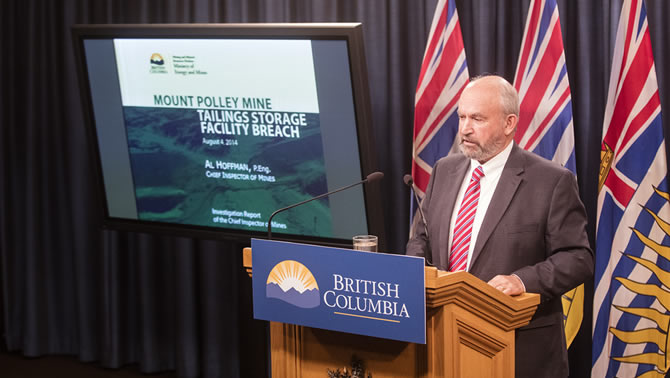BC Gov’t takes action on Chief Inspector of Mines’ recommendations on Mt Polley

Minister of Mines Bill Bennett responds to the Chief Inspector of Mines’ (CIM) investigation report. — Photo courtesy BC Government
In response to the findings and recommendations of the Chief Inspector of Mines’ (CIM) investigation into the tailings storage facility (TSF) at Mount Polley Mine in August 2014, Energy and Mines Minister Bill Bennett has announced that government will introduce new regulations and requirements that will make British Columbia a national and international leader in safety standards for tailings storage facilities.
The CIM report found, as did the Independent Expert Panel in January, that the dam failed because the strength and location of a layer of clay underneath the dam was not taken into account in the design or in subsequent dam raises. The chief inspector also found other factors including the slope of the perimeter embankment, inadequate water management, insufficient beaches and a sub-excavation at the outside toe of the dam exacerbated the collapse of the dam and the ensuing environmental damage.
While the breach would not have occurred had it not been for the undetected glaciolaucustrine layer of soils (UGLU), the consequences of the breach were made worse by the other factors. Although operations on the mine site were not in contravention of any regulation, the chief inspector found that the mine failed to operate using best available practices.
The chief inspector of mines investigation team conducted approximately 100 interviews and reviewed over 100,000 pages of documents going back to 1989. This is the largest and most-complex investigation and analysis ever done in B.C.
The CIM made 19 recommendations in seven categories directed toward the mining operator, the mining industry, professional organizations and the government regulator to prevent such incidents in the future and build a safer, more sustainable industry. Government will be working to implement all of the recommendations. Key recommendations include:
- All mines with TSFs will be required to have a designated mine dam safety manager and a designated individual to oversee the mine’s water balance and water management plan.
- Mines with TSFs will be required to have water management plans designed by a qualified professional.
- Independent technical review boards will be required for all mines with TSFs.
- Establish a dedicated investigation, compliance and enforcement team within the Ministry of Energy and Mines lead by a new deputy chief inspector of mines. This team will provide additional support and oversight of existing ministry investigation, compliance and enforcement functions.
- To strengthen records management and improve openness and transparency around design, construction and operation, government will establish a formal documentation management system for all TSFs from development to post-closure.
- Foster innovations in the mining sector that improve current technologies in tailings processing, dewatering and discharge water treatment.
Many of these recommendations will be addressed through the review of the Health, Safety and Reclamation Code for Mines in British Columbia. Government will also work with industry and professional organizations to implement the other recommendations. It is anticipated this work will be completed by spring 2017.
Other actions will be taken to strengthen government’s compliance and enforcement of mining. Bennett plans to introduce legislation in 2016 to add administrative penalties under the Mines Act. Compliance and enforcement tools under the Mines Act are presently limited to shutting down a mine through the cancellation of a permit, issuance of stop-work orders, or pursuing prosecutions. The proposed legislation would give ministry staff the power to issue penalties for non-compliance.
The chief inspector found that the mine and its engineers employed weak practices on the mine site and many recommendations go to new standards and guidelines to improve these practices. Weak practices, however, do not constitute a legal contravention of existing mining legislation. The CIM, with advice from the Ministry of Justice, did not find sufficient evidence that Mount Polley Mining Corporation contravened existing regulatory requirements. Based on these findings, the Chief Inspector of Mines determined there were no actions that would warrant a report to Crown Counsel pursuant to the Mines Act.
The British Columbia Conservation Officer Service (COS) is still conducting its investigation into the Mount Polley accident. The COS investigation is based on compliance with the Ministry of Environment legislation. It is possible that this investigation may find non-compliance that warrants a report to Crown Counsel.
Key Quotes:
Minister of Energy and Mines Bill Bennett –
“We’ve learned from this investigation that in the case of Mount Polley, the allowable margin of risk around the design, construction and management of the tailings storage facility was too narrow to allow for an unknown factor, the layer of unstable soils below the dam embankment.”
We've also learned that weak practices on the mine site increased the risk of dam failure and exacerbated environmental consequences from the breach.”
"This is unacceptable. My commitment is to implement all recommendations, work with the MABC and MAC, the APEGBC and the CDA to ensure that risk of dam failure is reduced by better regulations, better policies and better professional guidelines.”
Chief Inspector of Mines Al Hoffman –
“We conducted a very thorough and in-depth examination of the Mount Polley Mining Corporation’s actions from its initial site investigations 26 years ago to present. Through our investigation, we determined that while the mine did not contravene any existing regulatory requirements, its management and operational practices failed in a number of areas such as water management and misplaced confidence in the TSF design.”
“My recommendations address these issues and will strengthen British Columbia’s regulatory framework and build a safer, more sustainable industry in B.C.”
Learn More:
A copy of the Chief Inspector of Mines investigation is available here: www.gov.bc.ca/mountpolleyinvestigation




